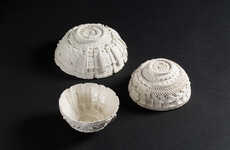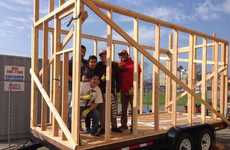
Textscapes Experiments in Rendering Fonts Fully Formed in Another Dimension
Amelia Roblin — January 21, 2015 — Art & Design
References: hongtaozhou & fubiz.net
Based on what people have experienced since the dawn of written language, lettering is aesthetically considered to be a two-dimensional medium. Now, here comes 3D-printed typography by Hongtao Zhou that literally extrudes character markings into another scope of space.
Using a 3D printer, this designer has translated a flat typed document into one with obvious texture. Each letter forming each word is extended away from its new-tech slate, keeping the familiar alphabetic shapes discernible when viewed straight-on. The cool look of it aside, Textscapes 3D-printed typography embodies particular beauty because of the implications for a wider base of readers. Those with visual impairments will be able to appreciate the tactility of these engaging raised fonts.
Using a 3D printer, this designer has translated a flat typed document into one with obvious texture. Each letter forming each word is extended away from its new-tech slate, keeping the familiar alphabetic shapes discernible when viewed straight-on. The cool look of it aside, Textscapes 3D-printed typography embodies particular beauty because of the implications for a wider base of readers. Those with visual impairments will be able to appreciate the tactility of these engaging raised fonts.
Trend Themes
1. Tactile Text - Designers are experimenting with 3D printing technology to create text that is more than just visually appealing, but also provides a tactile reading experience for those with visual impairments.
2. Accessible Design - 3D printing of typography can provide new ways to make traditional design accessible to a wider base of readers, particularly those with visual impairments.
3. Multi-dimensional Art - Artists and designers are exploring the creative potential of 3D printing technology to produce multi-dimensional typography that goes beyond the traditional flat surface.
Industry Implications
1. Printing Industry - The printing industry can utilize 3D printing technology to expand their services and offer customized products, such as 3D-printed typography.
2. Graphic Design Industry - Graphic designers can incorporate 3D-printed typography into their work to create more dynamic visual compositions and provide tactile experiences for readers.
3. Assistive Technology Industry - The use of 3D printing technology to create tactile typography can benefit the assistive technology industry by providing new ways to make information more accessible to those with visual impairments.
6.2
Score
Popularity
Activity
Freshness























